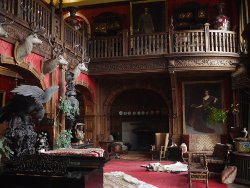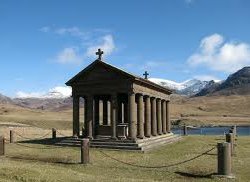History of the Kinloch Castle

History of the Kinloch Castle is closely related to the Bullough family that bought the Isle of Rum where it is located in 1888. John Bullough, a wealthy textile-mill owner who purchased the entire island wanted to create a shooting reserve but he did not enjoy the island for long. He died in 1891, leaving the Isle of Rum to his son George Bullough who decided to build him a mausoleum on the island. Today’s Doric style mausoleum, however, is not the original one. George Bullough had it demolished and replaced with the current one.
Shortly after he inherited the Island of Rum, George Bullough decided to build a castle as a summer and hunting retreat. The story goes that he wanted it to be of the same length as his yacht Rhouma but the castle was built only 150 feet long instead of 221 feet as the yacht. George Bullough commissioned the architectural firm Leeming & Leeming from London which started with the construction works in 1897. The Kinloch Castle was completed by 1901 at a cost of £250,000.

The castellated Tudor style castle was built from red sandstone which was brought from the Isle of Arran. From the very beginning, the Kinloch Castle had its own electricity which was generated by its own hydroelectric power plant in Coire Dubh as well as plumbing, telephone, heating and other at the time high-end equipment. The castle went through some alterations after Bullough’s marriage to Monique Lily de la Pasture who give it a bit of feminine touch.
Interestingly, the spectacular castle initially was not used by its owner but by the soldiers who were wounded during the Second Boer War (1899-1902). The owner of the Kinloch Castle decided to give his yacht Rhouma to the British navy to use it as a hospital ship as well as allowed the wounded soldiers to be brought to his newly built castle for which he was knighted in 1901. When the soldiers moved out, George Bullough moved in but he stayed there only during the shooting season. After the First World War, he was returning less frequently and eventually, the castle became neglected.
The Kinloch Castle remained in the Bullough family’s ownership until 1957, when Lady Monica sold both the castle and the Isle of Rum to the Nature Conservancy (the predecessor of the Scottish Natural Heritage which was formed in 1992). The Bullough family, however, retained ownership of the mausoleum which is the final resting place of both Lady Bullough (she died in 1967) and her husband George Bullough (he died in 1939).
The Nature Conservancy and later the Scottish Natural Heritage did their best to maintain the Kinloch Castle, however, its current owner could not prevent its deterioration due to the lack of the necessary funds for restoration. The castle made it to the finals of the BBC Restoration series in 2003 but unfortunately, it did not win the prize which would ensure the necessary funds for full scale restoration. The fate of the castle remains uncertain although its owner and a charitable organisation called the Kinloch Castle Friends Association are very active in raising funds for its restoration.